Information Security Program Lifecycle: An Ultimate Guide
Today we’re talking about the information security program lifecycle. we’ll be explaining the six stages of the information security program…we will see what exactly goes on in each of these stages.

Cyber attacks are growing in frequency. Security Magazine shares that over 2,200 attacks occur each day. When we break this down a bit more it’s about 1 cyber attack every 39 seconds.
Over the last four years, there has been a 239% increase in large breaches due to hacking in the healthcare industry.
In 2023, 88 million Americans experienced breaches of their protected health information (PHI).

Organizations should not take these statistics lightly. Think of it like this: it’s not a matter of if your organization experiences a cyber attack attempt but when.
What would you do? How would you fix it? Let’s back this up all the way up to the beginning.
What’s even the first step? Are you seeing the importance of a plan?
Today we’re talking about the information security program lifecycle. I’ll be explaining the six stages of the information security program…we will see what exactly goes on in each of these stages.
What is an Information Security Program Lifecycle?
Before we go too far into the weeds, let’s go over what an information security program is.
Think of it as your security playbook. It contains all the rules and regulations, policies and procedures to follow in order to keep all of your confidential information safe and secure.
National Institute of Standards and Technology (NIST) describes information security as, “The protection of information and information systems from unauthorized access, use, disclosure, disruption, modification, or destruction in order to provide confidentiality, integrity, and availability.”
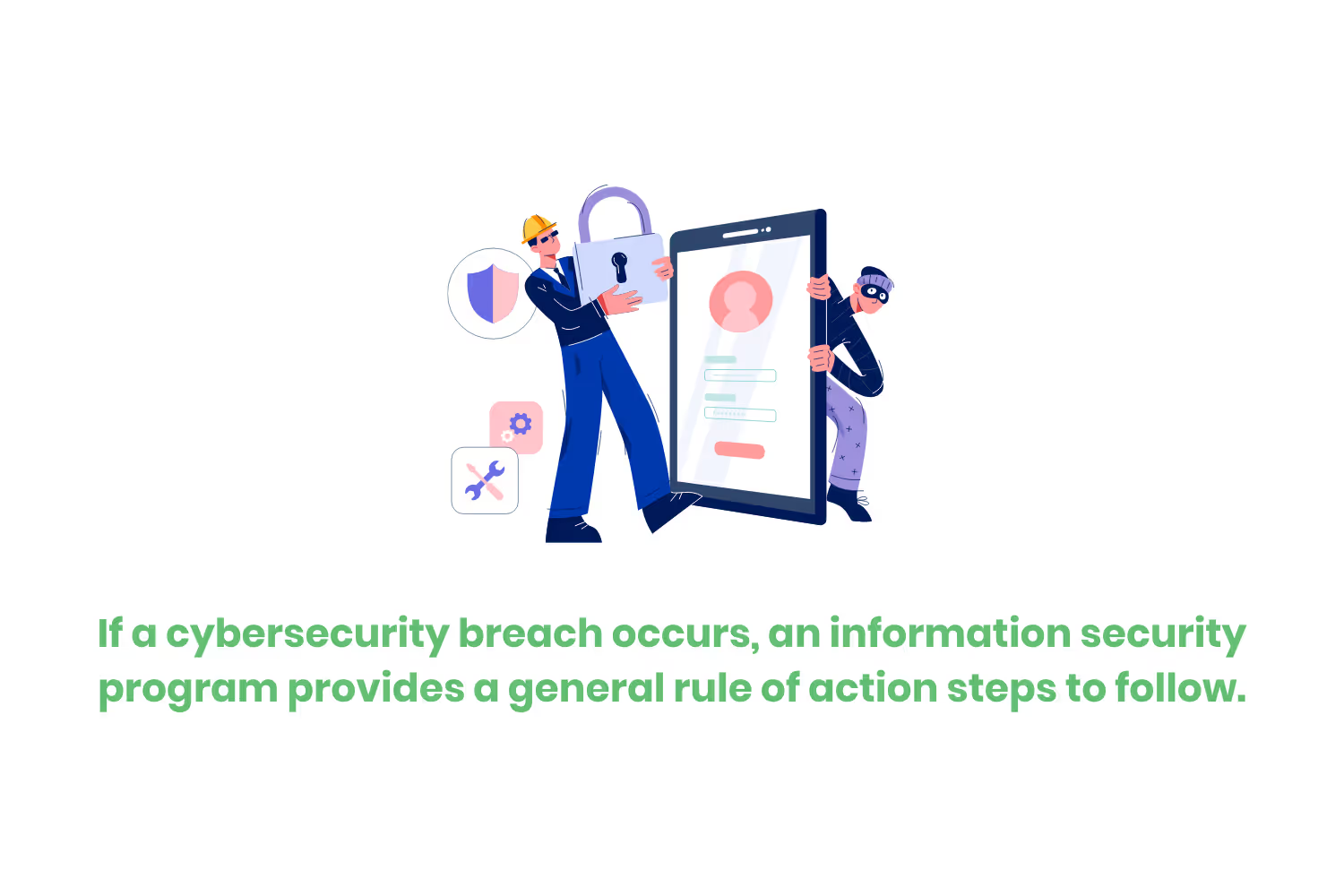
It’s a process that continuously manages and improves the security of all of an organization’s information systems. This includes all forms of information such as key business processes, IT assets, and employee or customer information.
Information security is different from cybersecurity.
Cybersecurity’s purpose is to protect only the safety of computer systems and digital data. Information security protects ALL forms of confidential information.
If a cybersecurity breach occurs, an information security program provides a general rule of action steps to follow.
The definition of a breach is, “a gap in a wall, barrier, or defense.” A data breach happens when a hacker is able to break through that security wall and access information.
Benefits of an Information Security Program
There are endless benefits to creating a strong and secure IT infrastructure, but let’s look at 3 big ones.
The 1st benefit of implementing an information security program is that it can boost your organization’s reputation.
Data breaches have the potential to make or break the reputation of your organization in the media.
Most if not all of us have probably heard a story about a huge corporation that experienced a data breach at some point. Spoiler alert, we go over some examples in an upcoming section. When you hear reports like this it can make you second guess whether or not you would trust them with your information.

If it already happened once, what’s to say that it won’t happen again? How was there a breach in the first place? Questions like these may run through your mind.
For some companies, all it takes is one time for a breach to happen and it completely alters their standings for success. Some have had to even close their doors for good.
On the bright side, showing customers that you’re making efforts to implement security practices and processes helps to build trust. Not to mention it decreases the chances of you experiencing a breach. If it does happen, you know what to do and can put a quick stop to it.
The 2nd benefit of implementing a security program is that it can save you from paying unnecessary costs.
There’s a whole lot of risk that comes with breaches. Monetary risk is one aspect. This risk also happens to be the biggest. The reality is that data breaches can cost your organization a ton of money.
As of 2023, the average cost of a data breach in the United States was around 9.48 million U.S. dollars.
Ransomware is a type of malware that blocks its victim’s access to data unless they pay a fee. The crazy thing is that companies will pay the ransomware fee and still not receive their information. It’s a lose-lose situation.
Studies show that there are 1.7 million ransomware attacks happening daily. Let’s break this down again. That’s about 19 ransomware attacks occurring every second!
The last benefit I’m going to write about is that implementing an information security program helps you to educate employees.
It’s all a learning process. Training your employees makes them aware of the importance of information security as well as the repercussions.
Did you know that human error accounts for 88% of all data breaches? That’s a pretty staggering statistic.
Awareness and acknowledgment are the first few steps to making true change. This is true in keeping employees in the loop on how to better protect themselves from common scams such as phishing as well as other types of malware attacks.
Data Breach Examples
Facebook - 2019
Let’s look at some examples of some pretty big data breaches that occurred within companies we’re all familiar with.
We’re all quite familiar with the social media outlet Facebook right? Chances are you might have one! Make sure to follow and like the Etactics Facebook page if you haven’t already (wink wink).
Facebook sees 3.05 billion monthly active users and 2.09 billion daily active users.
In April of 2019, Facebook experienced a data breach that impacted 533 million of those users.
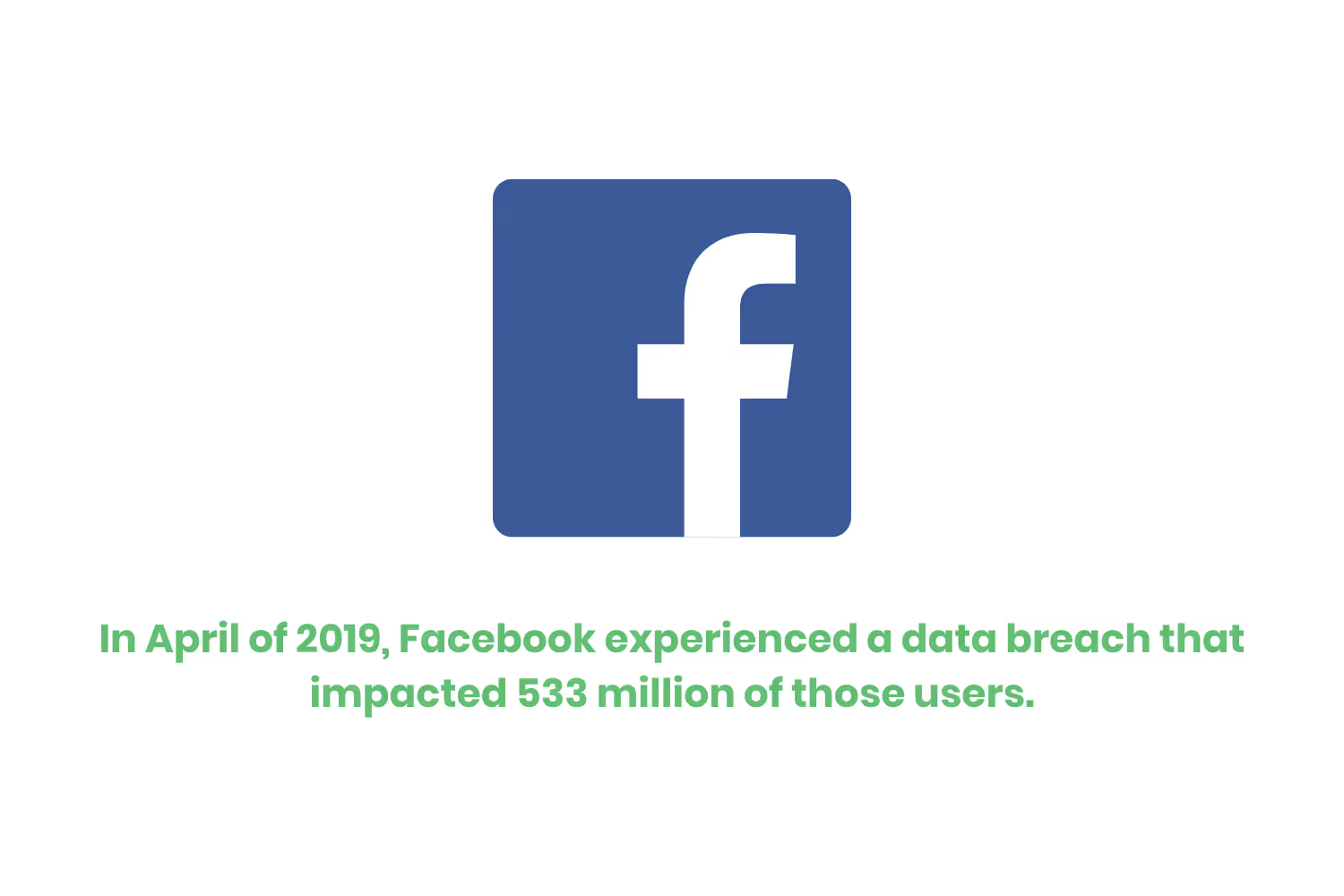
The UpGuard Cyber Risk team shared that 2 third-party app datasets had leaked to the public internet.
One originated from Cultura Colectiva, a media company based in Mexico. It contained over 533 million records which included personal likes, comments, reactions, account names, Facebook ids and more.
If this wasn’t enough, the same data set leaked to the dark web for free in April of 2021 making Facebook one of the most recent and largest companies hacked during this year.
Yahoo - 2013
One of the most infamous cases that holds the record for the most people affected is Yahoo.
The first attack occurred in 2013 and would last the next 3 years. Russian hackers broke into Yahoo’s database using backdoors, stolen backups, and access cookies.
The hackers stole names, emails, phone numbers, birth dates, passwords, calendars, and security questions from over 3 billion user accounts.
At first, Yahoo reported that only 1 billion accounts had stolen data. When Verizon bought out Yahoo in 2017, they released the news that the total number of accounts infected was around 3 billion.
Yahoo was slow to react to this incident altogether. They also failed to disclose the incident to users in 2014 which caused 41 class-action lawsuits and a $35 million fine.
There are many other infamous incidents that I could go on about, but we would be here all day. It just goes to show the importance of having a plan. Companies experience breaches due to poor processes and procedures. On top of that, they don’t know how to respond or what to do when the breaches happen.

Parts of an Information Security Program Lifecycle
Step 1: Planning
When it comes to an information security program, it all starts with laying out the grounds for a foundation. We’re starting in the development stage. In order to carry out policies and procedures for protecting sensitive information, you must create them first.
Start with identifying your security goals. What are you looking to achieve? The more specific you are in identifying any goals or objectives, the better.
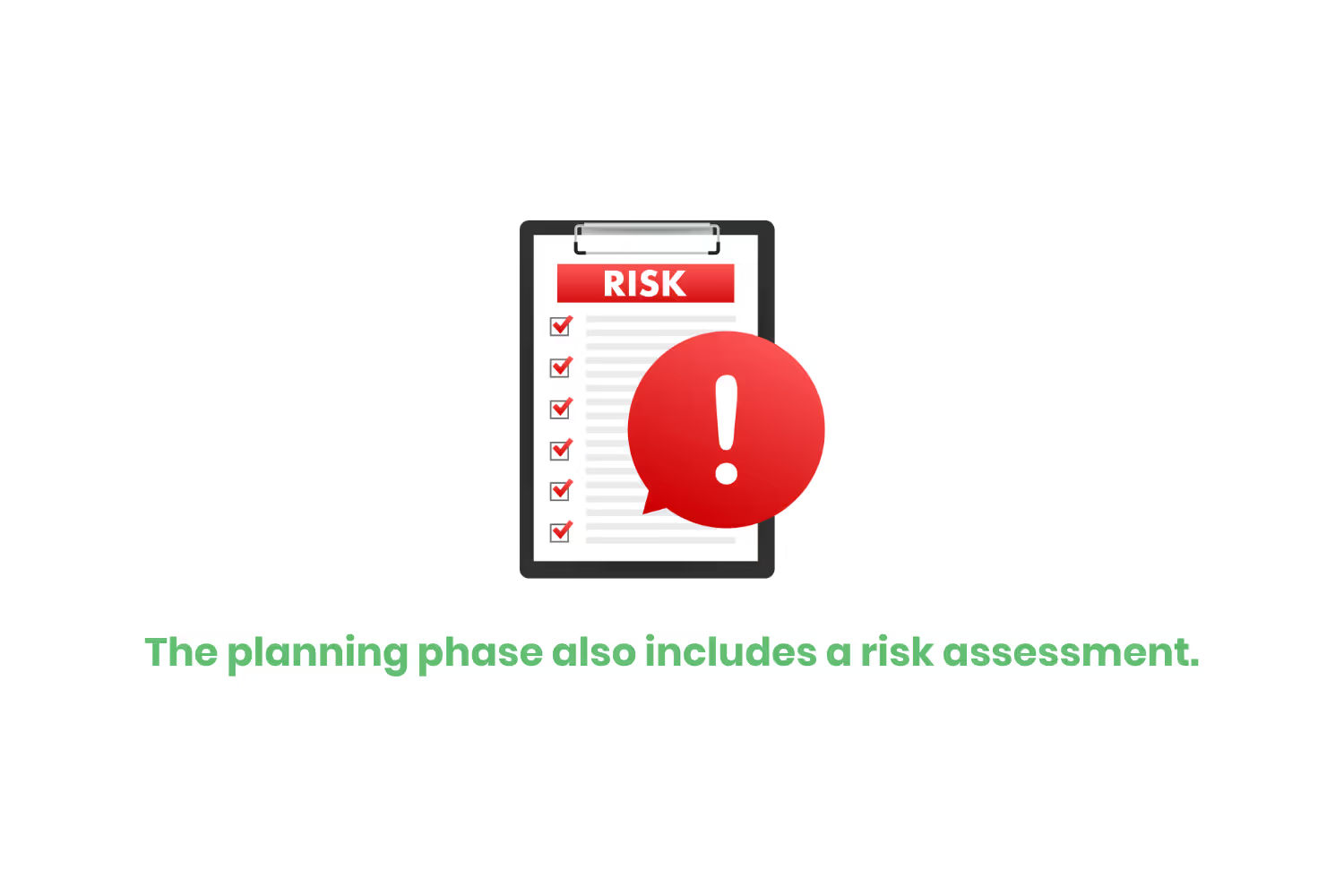
The strength of your program will depend on the goals at hand as well as the resources available.
The planning phase also includes a risk assessment. Assess your organization’s current state of information security as well as potential threats and vulnerability areas.
But this goes beyond a risk assessment. As I said, the more information, the better. Lay everything out on the table. Get your priorities in order and figure out your strengths and weaknesses.
Your plan should go beyond risk assessment and prevention recommendations. It must actively target issues and mitigate risk through diverse, inclusive projects.
Step 2: Implementation
The implementation stage is where you introduce these policies and procedures into your organization. This means making your employees aware of them.
Security awareness is crucial. Users are often the weakest security link. As I mentioned earlier, nearly 90% of all data breaches happen from an employee’s mistake.
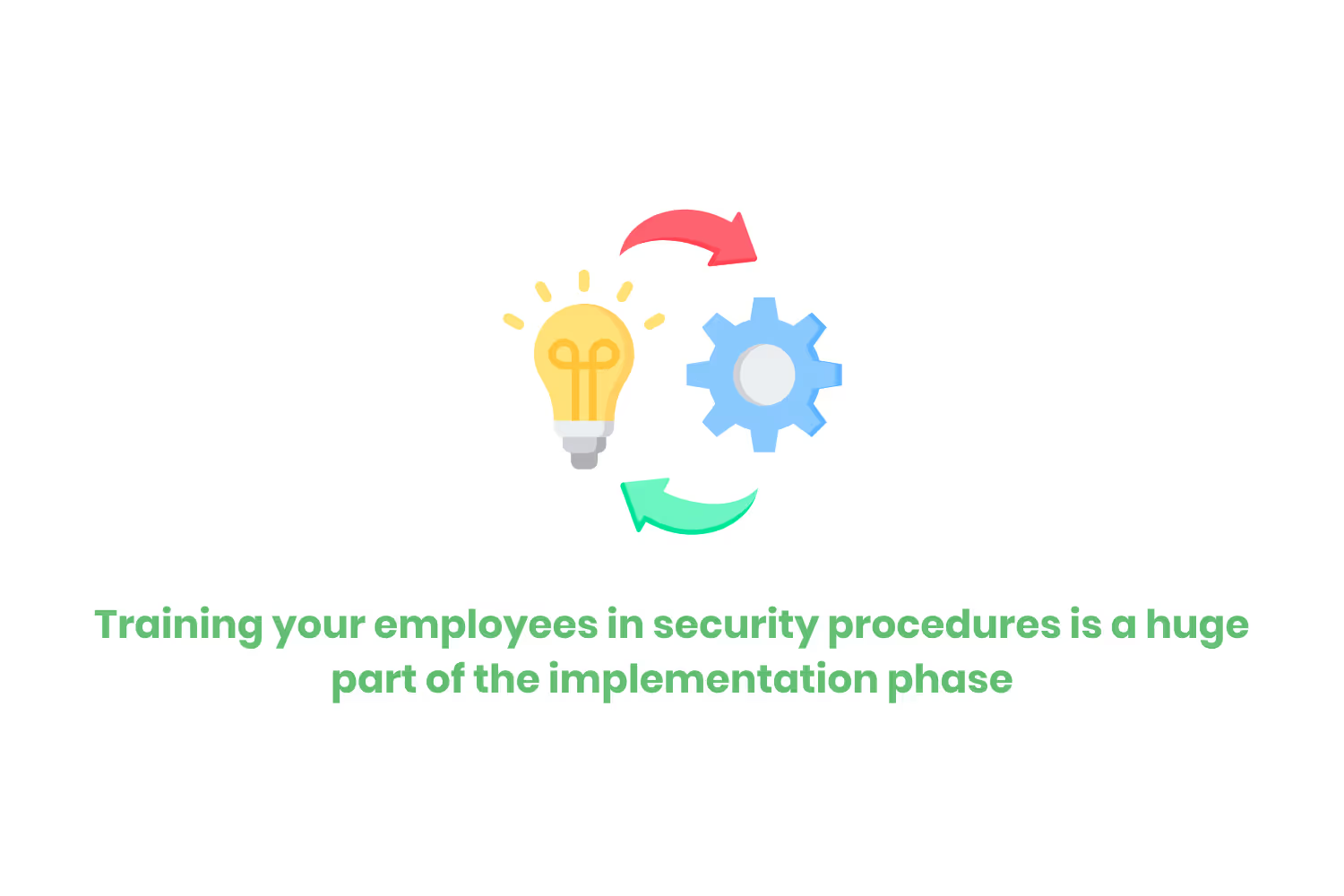
Employees must understand the policies and procedures to cultivate safe practices against various threats.
Training your employees in security procedures is a huge part of this phase. As well as installation of the necessary software and hardware.
Step 3: Operation
The operation stage involves putting the procedures and security measures into practice.
Carrying out day-to-day operations or functions in order to see the response. The fluidity of how everything is working. There is also monitoring the network for security breaches and responding to incidents which takes us to our next step.
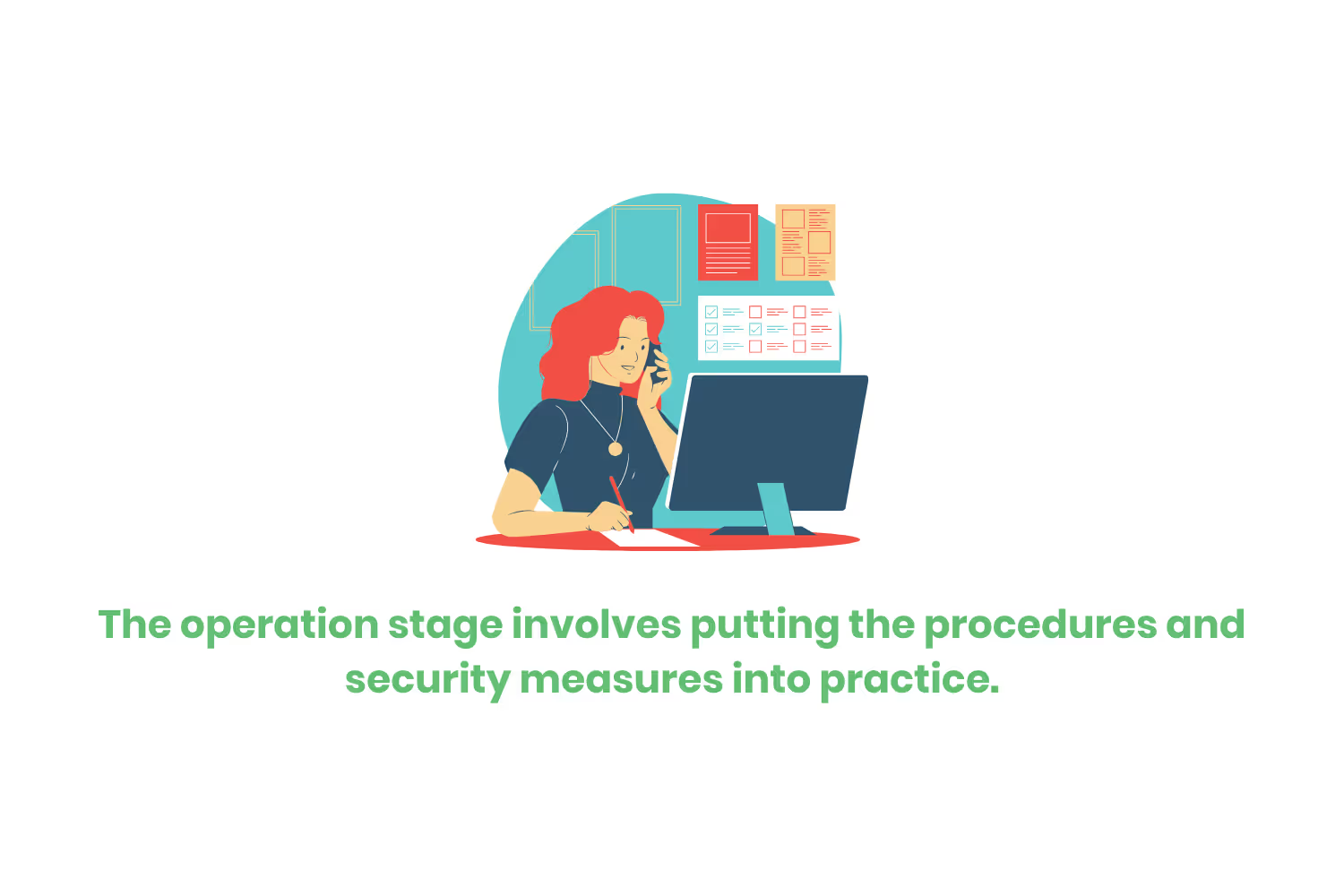
Step 4: Monitoring
Monitoring is a regular review of the security procedures to detect any changes.
In order to ensure that everything is working properly, there is a system of checks and balances. It involves regular testing which identifies any individuals or technological assets that may impact security or confidentiality.
Step 5: Maintenance
Maintenance involves regular updates to security policies and procedures. This description is short and simple but can take a lot of time to work out those kinks and make the right tweaks.
Step 6: Disposal
Disposal occurs when an organization removes all the data associated with its security system. This occurs to prevent unauthorized individuals from accessing sensitive data.
I want to add that a lot of these steps can double-dip. This isn’t a perfect process; you can’t just leave one step and go right into the other. It takes a lot of monitoring and analysis to figure out the right process for your organization.
Conclusion
An information security program that’s aligned with business objectives can better protect sensitive data as well as other information from cyber-attacks and threats.
It helps you to identify goals and weak areas, create processes to strengthen your security walls, and then monitor and assess these new efforts.
As hackers become more sophisticated and breaches continue to become more frequent we cannot deny the importance of implementing safe internet practices.
Staying educated on this topic and learning from previous incidents is a great way to ensure that we make improvements in securing personal information.
One small step for organization practices and procedures, one giant leap for information security!
Reach out to Etactics for more information on all things data and cybersecurity. Our K2 Akademy training modules on topics such as ransomware are insightful tools that make it easy for you to practice web safety.
Emphasize your product's unique features or benefits to differentiate it from competitors
In nec dictum adipiscing pharetra enim etiam scelerisque dolor purus ipsum egestas cursus vulputate arcu egestas ut eu sed mollis consectetur mattis pharetra curabitur et maecenas in mattis fames consectetur ipsum quis risus mauris aliquam ornare nisl purus at ipsum nulla accumsan consectetur vestibulum suspendisse aliquam condimentum scelerisque lacinia pellentesque vestibulum condimentum turpis ligula pharetra dictum sapien facilisis sapien at sagittis et cursus congue.
- Pharetra curabitur et maecenas in mattis fames consectetur ipsum quis risus.
- Justo urna nisi auctor consequat consectetur dolor lectus blandit.
- Eget egestas volutpat lacinia vestibulum vitae mattis hendrerit.
- Ornare elit odio tellus orci bibendum dictum id sem congue enim amet diam.
Incorporate statistics or specific numbers to highlight the effectiveness or popularity of your offering
Convallis pellentesque ullamcorper sapien sed tristique fermentum proin amet quam tincidunt feugiat vitae neque quisque odio ut pellentesque ac mauris eget lectus. Pretium arcu turpis lacus sapien sit at eu sapien duis magna nunc nibh nam non ut nibh ultrices ultrices elementum egestas enim nisl sed cursus pellentesque sit dignissim enim euismod sit et convallis sed pelis viverra quam at nisl sit pharetra enim nisl nec vestibulum posuere in volutpat sed blandit neque risus.

Use time-sensitive language to encourage immediate action, such as "Limited Time Offer
Feugiat vitae neque quisque odio ut pellentesque ac mauris eget lectus. Pretium arcu turpis lacus sapien sit at eu sapien duis magna nunc nibh nam non ut nibh ultrices ultrices elementum egestas enim nisl sed cursus pellentesque sit dignissim enim euismod sit et convallis sed pelis viverra quam at nisl sit pharetra enim nisl nec vestibulum posuere in volutpat sed blandit neque risus.
- Pharetra curabitur et maecenas in mattis fames consectetur ipsum quis risus.
- Justo urna nisi auctor consequat consectetur dolor lectus blandit.
- Eget egestas volutpat lacinia vestibulum vitae mattis hendrerit.
- Ornare elit odio tellus orci bibendum dictum id sem congue enim amet diam.
Address customer pain points directly by showing how your product solves their problems
Feugiat vitae neque quisque odio ut pellentesque ac mauris eget lectus. Pretium arcu turpis lacus sapien sit at eu sapien duis magna nunc nibh nam non ut nibh ultrices ultrices elementum egestas enim nisl sed cursus pellentesque sit dignissim enim euismod sit et convallis sed pelis viverra quam at nisl sit pharetra enim nisl nec vestibulum posuere in volutpat sed blandit neque risus.
Vel etiam vel amet aenean eget in habitasse nunc duis tellus sem turpis risus aliquam ac volutpat tellus eu faucibus ullamcorper.
Tailor titles to your ideal customer segment using phrases like "Designed for Busy Professionals
Sed pretium id nibh id sit felis vitae volutpat volutpat adipiscing at sodales neque lectus mi phasellus commodo at elit suspendisse ornare faucibus lectus purus viverra in nec aliquet commodo et sed sed nisi tempor mi pellentesque arcu viverra pretium duis enim vulputate dignissim etiam ultrices vitae neque urna proin nibh diam turpis augue lacus.



![[ANSWERED] What to do if your email is on the dark web?](https://cdn.prod.website-files.com/67e2b8210878abcba6f91ae6/68adc0209238d61bc357cb8d_EmailonTheDarkWeb_1224.avif)
![[ANSWERED] What is Dark Web Monitoring?](https://cdn.prod.website-files.com/67e2b8210878abcba6f91ae6/68adbe4fe3e9533f2c658048_WhatisDarkWebMonitoring_1224.avif)